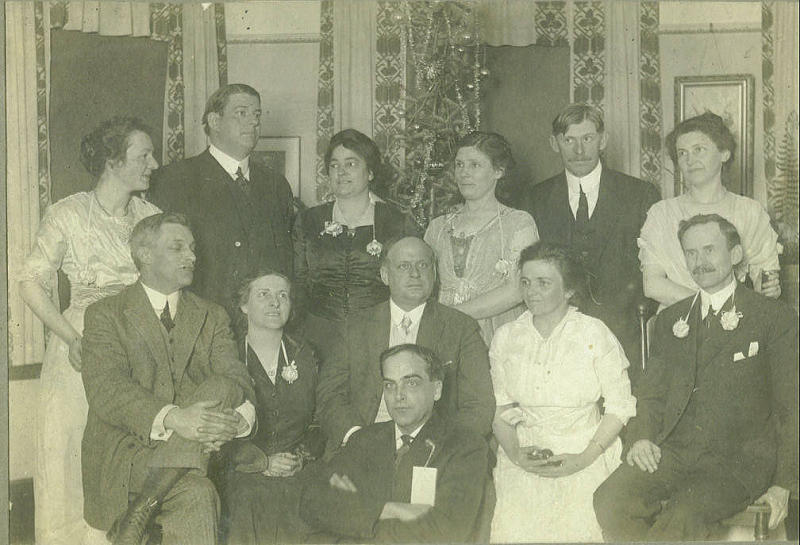Livingston Manor Notables

The gentleman seated in front, with his arm's crossed, is A.L. Sherman. The row seated behind Mr. Sherman are, from left to right; Bill Gimmel; Mrs. Gimmel; George Woolsey; Mrs. Woolsey; F.B. Johnston. Standing in the back row, again left to right; Mrs. Sherman; Mr.DuBois; Mrs. Frank Johnston; Mrs. DuBois; Dr. Davis; Mrs. Davis
As evidenced by the Christmas decorations behind Mrs. Johnston and Mrs.
DuBois, the photograph was taken during the Christmas season, but the year
is unknown. Still, there are enough clues within the image that can give an
approximate date.
Mr. A.L. Sherman, who sits in front, was, for a period of time, the editor
of the Livingston Manor Times. William O. Ensign, publisher and owner of the
newspaper during the beginning of the twentieth century, First called The
Ensign and later changed to the Livingston Manor Times, tired of the
newspaper business and joined his brother in prospecting for minerals in
Montana. He probably also tired of the Manor, especially when he found that
his wife was having an affair She eventually up and left him. Upon himself
leaving for the West, Sherman took over as Mr. Ensign's editor of the
newspaper during the spring of 1913. This lasted until Ensign sold the
business to Harold Forbes in 1917. With Forbes now being the publisher,
Elmer Myers became the new editor; Mr. Myers was my grandfather.
With A.L. Sherman being part of the group, the photograph would probably
have been taken between the Christmas season of 1913 to the Christmas season
of 1916.
The stern-looking gentleman sitting behind Mr. Sherman in the Who's Who
photograph is George S. Woolsey, the youngest son of the lumber
entrepreneur, P.H. Woolsey. George was trained to be a teacher and taught at
the Livingston Manor school for many years, serving also as its
administrator. He left the Manor for a short time and went to work for the
YMCA, residing at Cortland and Syracuse. When Charles B. Ward purchased the
weekly newspaper, in 1909, he enticed Woolsey to return to the Manor and
serve as his newspaper's editor.
After spending three years at Ward's Liberty Register, and with William
Ensign loosing interest in the Livingston Manor newspaper,
Woolsey joined up with Editor A.L. Sherman and helped publish the Livingston
Manor Times. When Howard Forbes became the publisher and owner of the Times,
Woolsey left the Manor for East Orange, New Jersey, where he and his wife
lived until his death, not long after this photograph was taken, in 1921 at
the relatively young age of 46 years.
Seated next to to Woolsey, to his left and in the white dress, is his wife,
Nellie Dodge, daughter of Montgomery and Jenette Maybe
Dodge of Rockland. They married in 1899, moving into his recently built
house on the corner of Pearl Street and Rock Avenue, next to the
Presbyterian Church and its parsonage. Like his parents, George and Nellie
were heavy contributors to that church, both in time and money, donating the
"Woolsey Window", in memory of his parents who helped found the Manor
church, during the church's first renovation.
Nellie did not share the same fate as that of her husband's early death, for
she lived up to the age of 90 years, passing away in 1969.
Fred Fries - August 6, 2007
Another member of one of Livingston Manor's prominent families is
standing in the back row, on the left. Louis DuBois was the son of Alvin
Preston DuBois, who came to Livingston Manor in 1873 as a junior partner of
the company "John H. Devine & Co.", which operated a department store at
Ellenville and opened a branch at Morsston. The store sold everything from
groceries to hardware and clothing.
When John Devine retired in 1881, the business then became known as "A.P.
DuBois & Co.", with A.P. DuBois as president. Louis, after graduating from
Colgate, returned home and went to work as a store employee, eventually
becoming the secretary for the company. When his father died in 1907, Louis
was elected president of the company, which was operated successfully until
it finally closed in 1925.
Two years later, Louis started the fuel busines, handling coal, fuel oil and
bottled gas. For a while he worked at the Livingston Manor
Bank, his daughter, Carolyne, and wife running the business. Besides the
fuel business offices being located at the DuBois building, he
also conducted a haberdashery business there, as well as renting out
business space to Charles Fallon, a barber, and Charles Fuhrer, who took
over the George Lathrop pharmarcy.
Fred Fries - August 8, 2007
The fellow standing in the back row, on the right, of the "Who's Who"
photograph is Doctor J. William Davis. Davis was a "homegrown" doctor which
added to his immense popularity. His father, James "Wals" Davis, came from a
family that settled in Morsston. After returning from the Civil War, "Wals"
for a brief period operated the old Purvis Hotel, at Jacktown, eventually
purchasing the manor house of Edward Livingston and converting it into a
hotel that became known as the Manor House. In 1885, "Wals" sold the
thriving hotel to W.F. Clay and began erecting another hotel across the
street, which became known as the Hotel Davis, later known as the Hotel
Sherwood.
After attending the local school, young Davis received his medical training
at New York, returning to the area and opening his doctor's office at
Jeffersonville in 1904. By 1910, he moved his practice to Livingston Manor
and built his spacious home on DuBois Street, which included both his
residence and office.
In 1933, while on his way to his hunting camp above Willowemoc with his wife
and grandchildren, his car became lodged upon a stump. In his attempt to
chop the obstacle away from his vehicle, he suffered a heart attack and
dropped dead on the spot.
Fred Fries - August 20, 2007